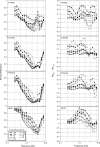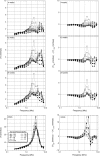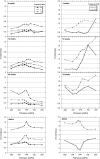Effects of maturation on tympanometric wideband acoustic transfer functions in human infants
- PMID: 19062852
- PMCID: PMC2600624
- DOI: 10.1121/1.2967864
Effects of maturation on tympanometric wideband acoustic transfer functions in human infants
Abstract
Wideband acoustic transfer function (ATF) measurements of energy reflectance (ER) and admittance magnitude (|Y|) were obtained at varying static ear-canal pressures in 4-, 12-, and 27-week-old infants and young adults. Developmental changes in wideband ATF measurements varied as a function of frequency. For frequencies from 0.25 to 0.75 kHz there was as much as a 30% change in mean ER and mid |Y| with changes in static ear-canal pressure between 4 and 24 weeks of age. From 0.75 to 2 kHz, the effects of pressure produced a small number of significant differences in ER and mid |Y| with age, suggestive of a developmentally stable frequency range. Between 2 and 6 kHz, there were differential effects of pressure for the youngest infants; negative pressures caused increased ER and mid |Y| and positive pressures caused decreased ER and mid |Y|; the magnitude of this effect decreased with age. Findings from this study demonstrate developmental differences in wideband tympanometric ATF measurements in 4-, 12- and 24-week-old infants and provide additional insight on the effects of static ear-canal pressure in the young infant's ear. The maturational effects shown in the experimental data are discussed in light of known age-related anatomical changes in the developing outer and middle ear.
Figures








Similar articles
-
Effect of ear canal pressure and age on wideband absorbance in young infants.Int J Audiol. 2017 May;56(5):346-355. doi: 10.1080/14992027.2017.1284352. Epub 2017 Feb 8. Int J Audiol. 2017. PMID: 28599603
-
Normative Wideband Reflectance, Equivalent Admittance at the Tympanic Membrane, and Acoustic Stapedius Reflex Threshold in Adults.Ear Hear. 2017 May/Jun;38(3):e142-e160. doi: 10.1097/AUD.0000000000000399. Ear Hear. 2017. PMID: 28045835 Free PMC article.
-
Procedures for ambient-pressure and tympanometric tests of aural acoustic reflectance and admittance in human infants and adults.J Acoust Soc Am. 2015 Dec;138(6):3625-53. doi: 10.1121/1.4936946. J Acoust Soc Am. 2015. PMID: 26723319 Free PMC article.
-
Wideband acoustic immittance measures: developmental characteristics (0 to 12 months).Ear Hear. 2013 Jul;34 Suppl 1:17S-26S. doi: 10.1097/AUD.0b013e31829db914. Ear Hear. 2013. PMID: 23900174 Review.
-
Wideband acoustic immittance: tympanometric measures.Ear Hear. 2013 Jul;34 Suppl 1:65S-71S. doi: 10.1097/AUD.0b013e31829c7250. Ear Hear. 2013. PMID: 23900184 Review.
Cited by
-
Longitudinal Development of Distortion Product Otoacoustic Emissions in Infants With Normal Hearing.Ear Hear. 2018 Sep/Oct;39(5):863-873. doi: 10.1097/AUD.0000000000000542. Ear Hear. 2018. PMID: 29369290 Free PMC article.
-
Acoustic Immittance, Absorbance, and Reflectance in the Human Ear Canal.Semin Hear. 2015 Feb;36(1):11-28. doi: 10.1055/s-0034-1396924. Semin Hear. 2015. PMID: 27516708 Free PMC article.
-
Effects of middle-ear disorders on power reflectance measured in cadaveric ear canals.Ear Hear. 2012 Mar-Apr;33(2):195-208. doi: 10.1097/AUD.0b013e31823235b5. Ear Hear. 2012. PMID: 22037477 Free PMC article.
-
Sound-conduction effects on distortion-product otoacoustic emission screening outcomes in newborn infants: test performance of wideband acoustic transfer functions and 1-kHz tympanometry.Ear Hear. 2009 Dec;30(6):635-52. doi: 10.1097/AUD.0b013e3181b61cdc. Ear Hear. 2009. PMID: 19701089 Free PMC article.
-
Effect of Cochlear Implantation on Vestibular Evoked Myogenic Potentials and Wideband Acoustic Immittance.Ear Hear. 2020 Sep/Oct;41(5):1111-1124. doi: 10.1097/AUD.0000000000000831. Ear Hear. 2020. PMID: 32032225 Free PMC article.
References
-
- Alaerts, J., Luts, H., and Wouters, J. (2007). “Evaluation of middle ear function in young children: Clinical guidelines for the use of 226- and 1,000-Hz tympanometry,” Otol. Neurotol. ONTEAE 28, 727–732. - PubMed
-
- Baldwin, M. (2006). “Choice of probe tone and classification of trace patterns in tympanometry undertaken in early infancy,” Int. J. Audiol. ZZZZZZ 45, 417–427. - PubMed
-
- Calandruccio, L., Fitzgerald, T. S., and Prieve, B. A. (2006). “Normative multifrequency tympanometry in infants and toddlers,” J. Am. Acad. Audiol ZZZZZZ 17, 470–480. - PubMed
-
- Eby, T. L., and Nadol, J. B., Jr. (1986). “Postnatal growth of the human temporal bone. Implications for cochlear implants in children,” Ann. Otol. Rhinol. Laryngol. AORHA2 95, 356–364. - PubMed
Publication types
MeSH terms
Grants and funding
LinkOut - more resources
Full Text Sources
Other Literature Sources

